

Compact Muon Solenoid
LHC, CERN
| CMS-EXO-21-019 ; CERN-EP-2023-301 | ||
| Search for pair production of scalar and vector leptoquarks decaying to muons and bottom quarks in proton-proton collisions at $ \sqrt{s}= $ 13 TeV | ||
| CMS Collaboration | ||
| 9 February 2024 | ||
| PRD 109 (2024) 112003 | ||
| Abstract: A search for pair production of scalar and vector leptoquarks (LQs) each decaying to a muon and a bottom quark is performed using proton-proton collision data collected at $ \sqrt{s}= $ 13 TeV with the CMS detector at the CERN LHC, corresponding to an integrated luminosity of 138 fb$ ^{-1} $. No excess above standard model expectation is observed. Scalar (vector) LQs with masses less than 1810 (2120) GeV are excluded at 95% confidence level, assuming a 100% branching fraction of the LQ decaying to a muon and a bottom quark. These limits represent the most stringent to date. | ||
| Links: e-print arXiv:2402.08668 [hep-ex] (PDF) ; CDS record ; inSPIRE record ; HepData record ; Physics Briefing ; CADI line (restricted) ; | ||
| Figures | |

png pdf |
Figure 1:
Dominant leading order Feynman diagrams for pair production of LQs at the LHC. |
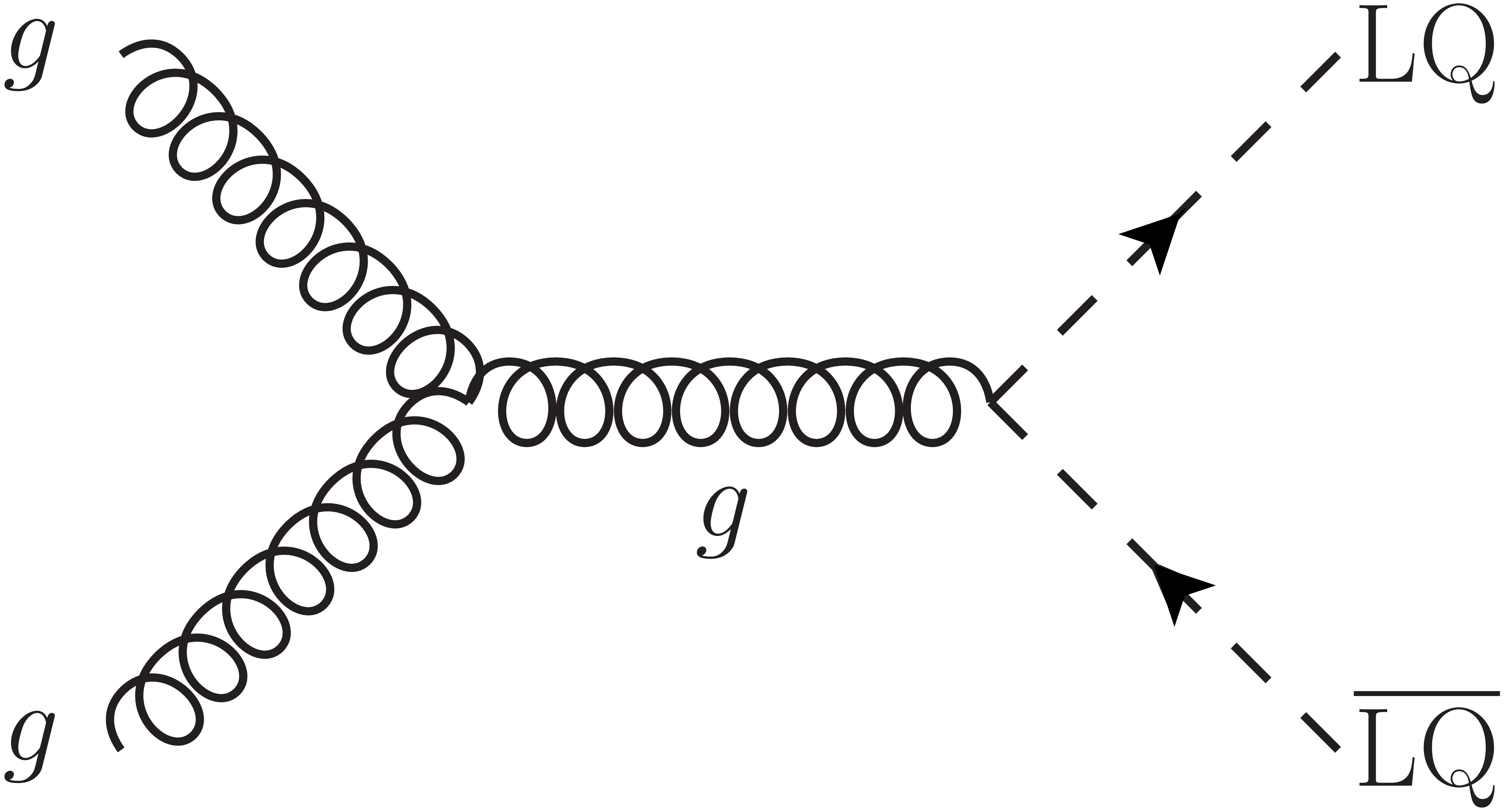
png pdf |
Figure 1-a:
Leading order Feynman diagram for pair production of LQs at the LHC. |
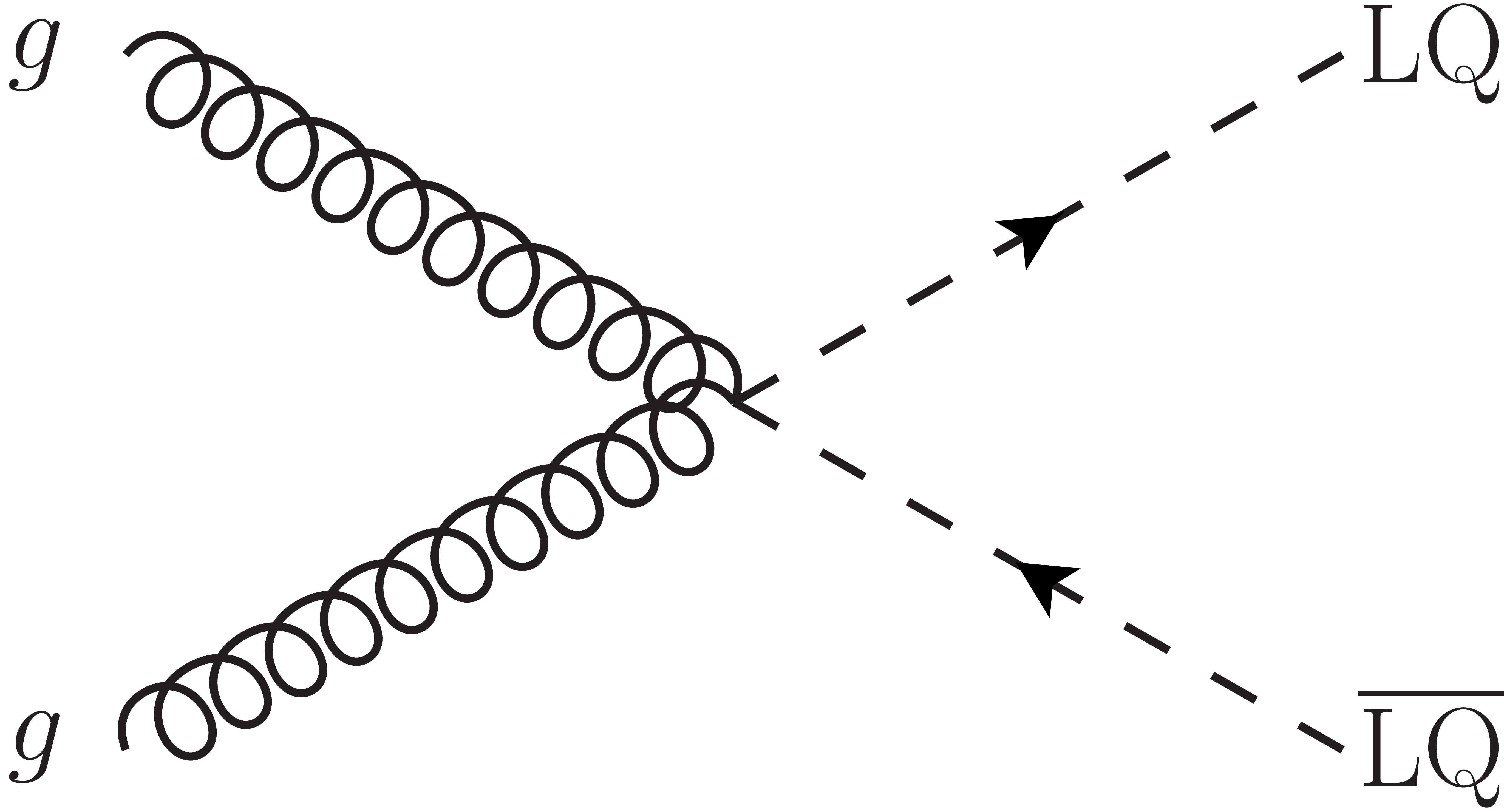
png pdf |
Figure 1-b:
Leading order Feynman diagram for pair production of LQs at the LHC. |
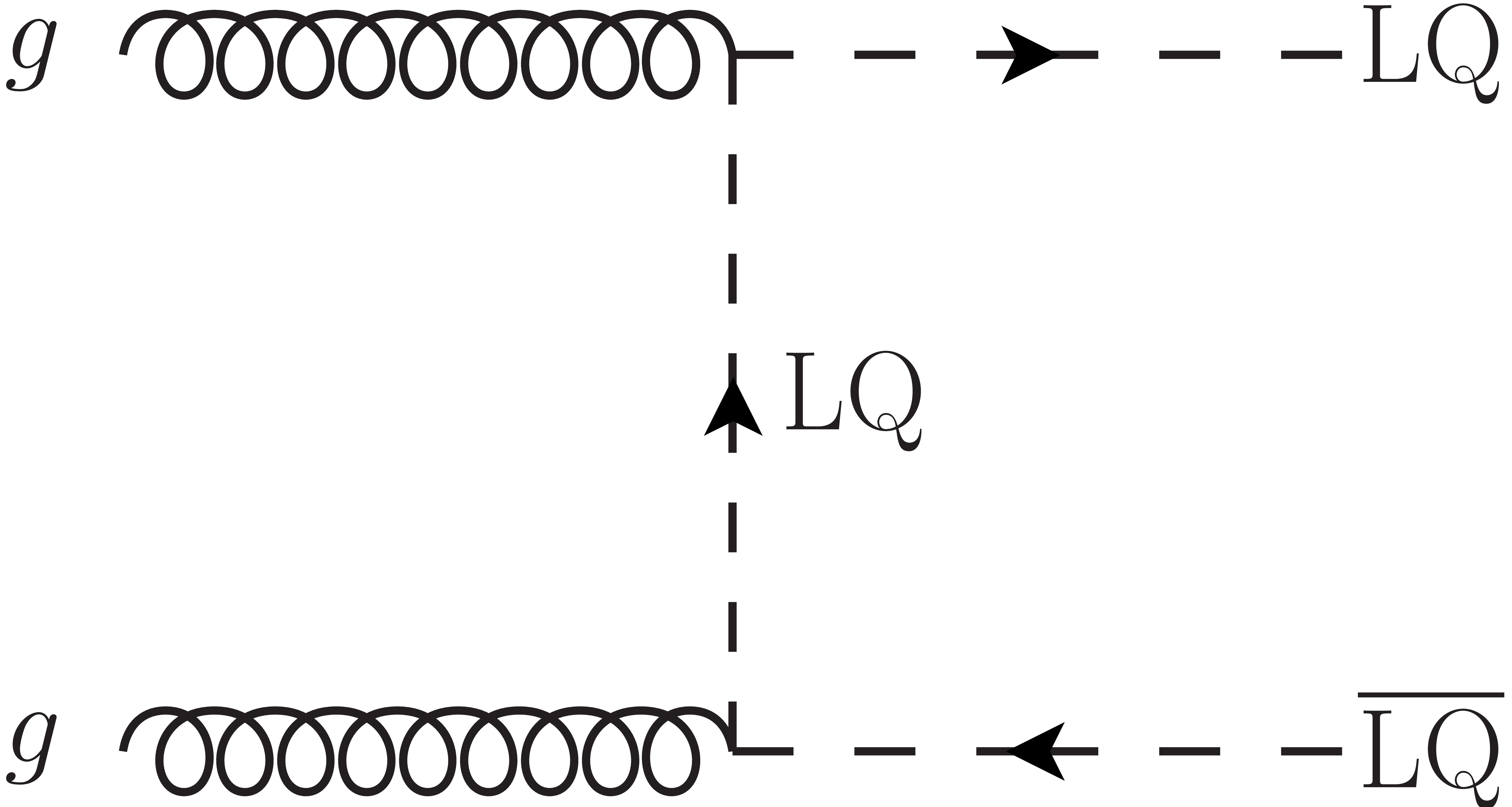
png pdf |
Figure 1-c:
Leading order Feynman diagram for pair production of LQs at the LHC. |
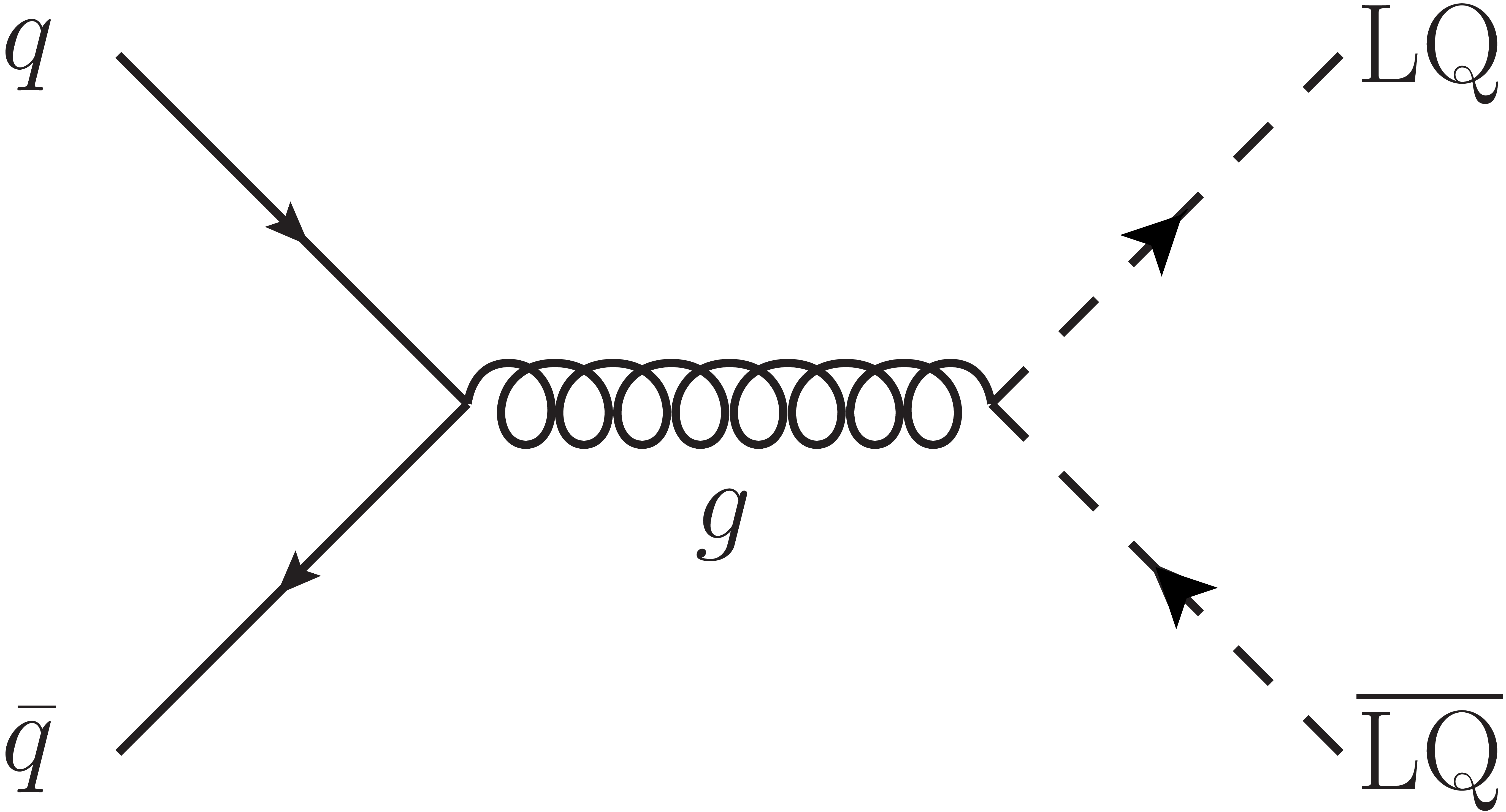
png pdf |
Figure 1-d:
Leading order Feynman diagram for pair production of LQs at the LHC. |

png pdf |
Figure 2:
Comparison of data and background $ m_{\mu\mu} $ distribution at the preselection level for the $ \mathrm{Z}/\gamma^* $+jets and $ \mathrm{t} \bar{\mathrm{t}} $+jets (left) and diboson and $ {\mathrm{t}\bar{\mathrm{t}}} \mathrm{V} $ (right) background control regions, with the corresponding data-to-background ratio shown below. For $ \mathrm{Z}/\gamma^* $+jets, the control region is a $ m_{\mu\mu} $ window of 80-100 GeV around the Z peak, and for $ \mathrm{t} \bar{\mathrm{t}} $ +jets is a window of 100-250 GeV. For diboson and $ {\mathrm{t}\bar{\mathrm{t}}} \mathrm{V} $ processes, the normalization is performed simultaneously, with a control region again of 80-100 GeV around the Z peak, but with a third lepton requirement (to remain orthogonal to the $ \mathrm{Z}/\gamma^* $+jets control region) and no b tag requirement (to diminish the statistical uncertainty). The error bars are the data statistical uncertainties, while the shaded band represents the combined statistical and systematic uncertainty in the full background estimate. The signal contribution in all control regions is negligible. |
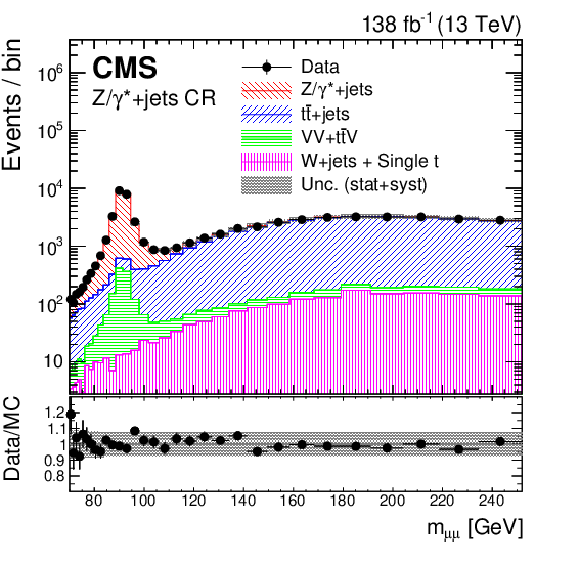
png pdf |
Figure 2-a:
Comparison of data and background $ m_{\mu\mu} $ distribution at the preselection level for the |

png pdf |
Figure 2-b:
Comparison of data and background $ m_{\mu\mu} $ distribution at the preselection level for the $ \mathrm{Z}/\gamma^* $+jets and $ \mathrm{t} \bar{\mathrm{t}} $+jets (left) and diboson and $ {\mathrm{t}\bar{\mathrm{t}}} \mathrm{V} $ (right) background control regions, with the corresponding data-to-background ratio shown below. For $ \mathrm{Z}/\gamma^* $+jets, the control region is a $ m_{\mu\mu} $ window of 80-100 GeV around the Z peak, and for $ \mathrm{t} \bar{\mathrm{t}} $ +jets is a window of 100-250 GeV. For diboson and $ {\mathrm{t}\bar{\mathrm{t}}} \mathrm{V} $ processes, the normalization is performed simultaneously, with a control region again of 80-100 GeV around the Z peak, but with a third lepton requirement (to remain orthogonal to the $ \mathrm{Z}/\gamma^* $+jets control region) and no b tag requirement (to diminish the statistical uncertainty). The error bars are the data statistical uncertainties, while the shaded band represents the combined statistical and systematic uncertainty in the full background estimate. The signal contribution in all control regions is negligible. |
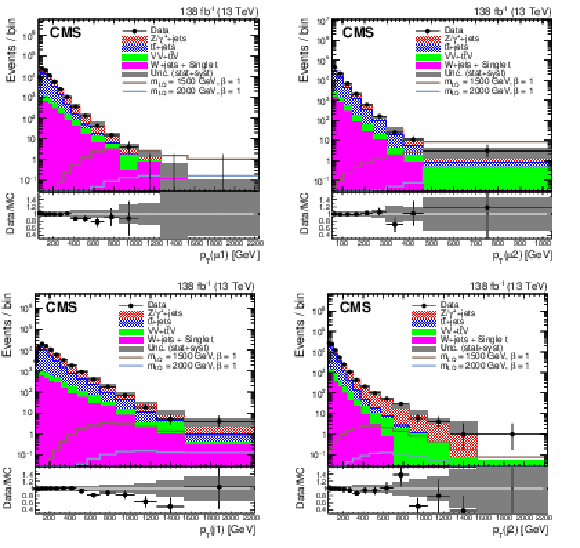
png pdf |
Figure 3:
Comparison of data and background $ p_{\mathrm{T}} $ distribution at the preselection level for the leading two muons and jets. The error bars are the data statistical uncertainties, while the shaded band represents the combined statistical and systematic uncertainty in the full background estimate. |

png pdf |
Figure 3-a:
Comparison of data and background $ p_{\mathrm{T}} $ distribution at the preselection level for the leading two muons and jets. The error bars are the data statistical uncertainties, while the shaded band represents the combined statistical and systematic uncertainty in the full background estimate. |

png pdf |
Figure 3-b:
Comparison of data and background $ p_{\mathrm{T}} $ distribution at the preselection level for the leading two muons and jets. The error bars are the data statistical uncertainties, while the shaded band represents the combined statistical and systematic uncertainty in the full background estimate. |

png pdf |
Figure 3-c:
Comparison of data and background $ p_{\mathrm{T}} $ distribution at the preselection level for the leading two muons and jets. The error bars are the data statistical uncertainties, while the shaded band represents the combined statistical and systematic uncertainty in the full background estimate. |
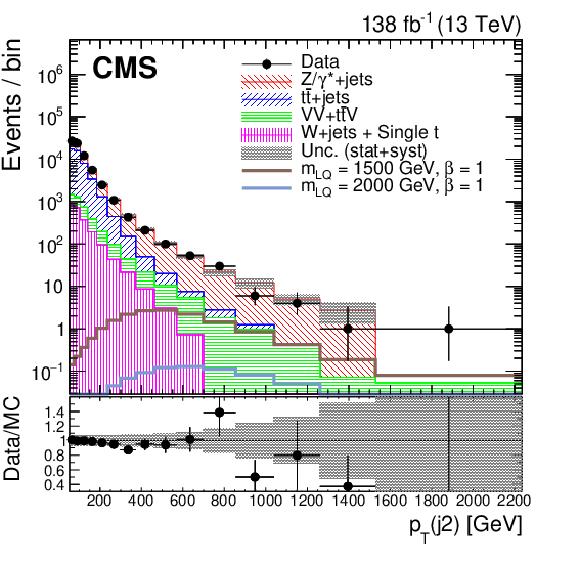
png pdf |
Figure 3-d:
Comparison of data and background $ p_{\mathrm{T}} $ distribution at the preselection level for the leading two muons and jets. The error bars are the data statistical uncertainties, while the shaded band represents the combined statistical and systematic uncertainty in the full background estimate. |

png pdf |
Figure 4:
Comparison of data and background BDT discriminant distributions at the preselection level for LQ mass hypotheses of 1500 GeV (upper left), 1800 GeV (upper right), and 2000 GeV (lower). The error bars are the data statistical uncertainties, while the shaded band represents the combined statistical and systematic uncertainty in the full background estimate. |
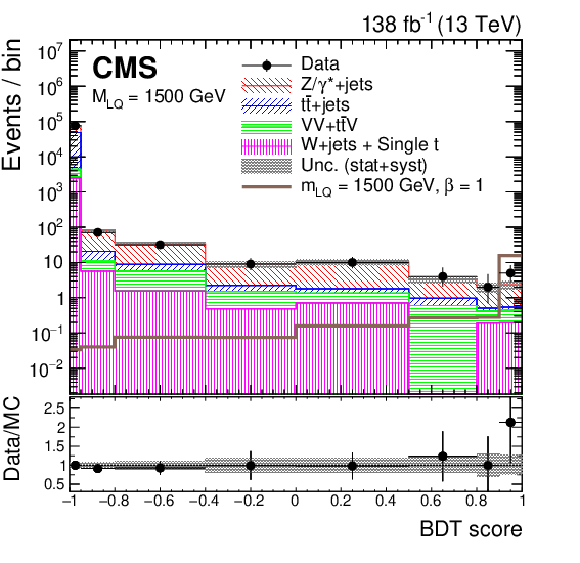
png pdf |
Figure 4-a:
Comparison of data and background BDT discriminant distributions at the preselection level for LQ mass hypotheses of 1500 GeV (upper left), 1800 GeV (upper right), and 2000 GeV (lower). The error bars are the data statistical uncertainties, while the shaded band represents the combined statistical and systematic uncertainty in the full background estimate. |
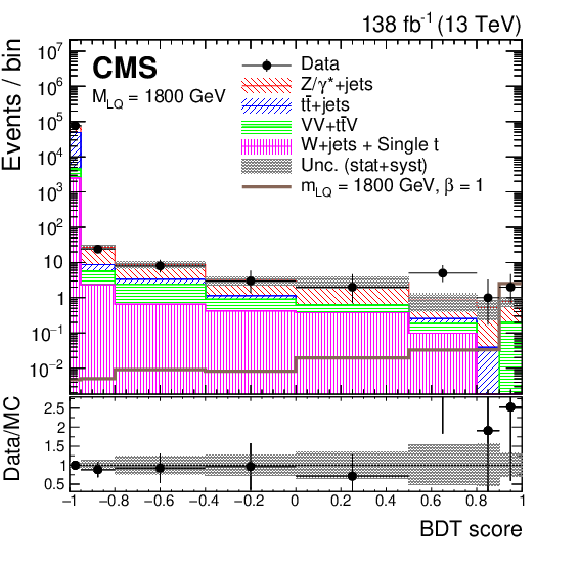
png pdf |
Figure 4-b:
Comparison of data and background BDT discriminant distributions at the preselection level for LQ mass hypotheses of 1500 GeV (upper left), 1800 GeV (upper right), and 2000 GeV (lower). The error bars are the data statistical uncertainties, while the shaded band represents the combined statistical and systematic uncertainty in the full background estimate. |
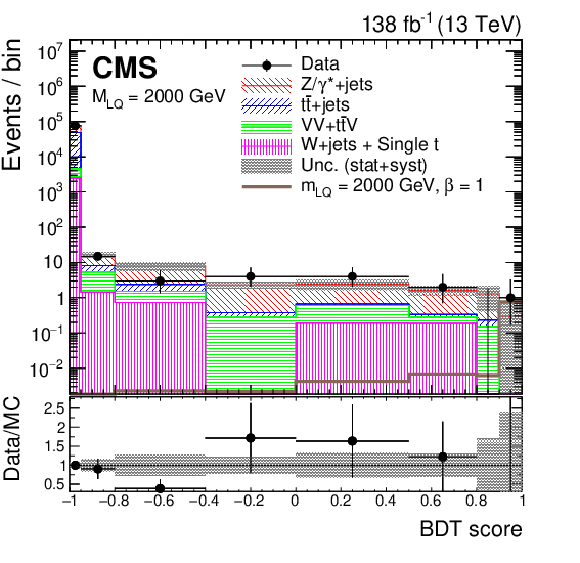
png pdf |
Figure 4-c:
Comparison of data and background BDT discriminant distributions at the preselection level for LQ mass hypotheses of 1500 GeV (upper left), 1800 GeV (upper right), and 2000 GeV (lower). The error bars are the data statistical uncertainties, while the shaded band represents the combined statistical and systematic uncertainty in the full background estimate. |
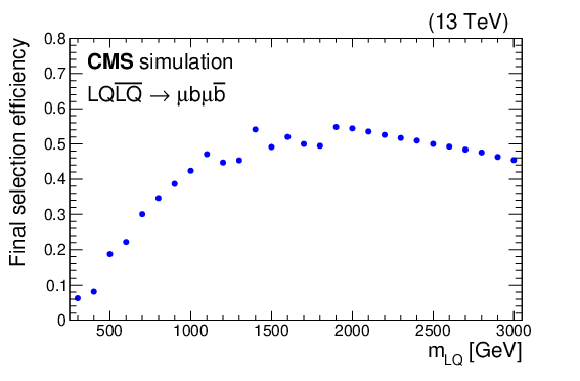
png pdf |
Figure 5:
Total signal selection efficiency, defined as the number of events passing the final selection divided by the number of generated events. The discrete nature of the individual BDT training and final selection for each LQ candidate mass produces the observed variation in the efficiency. Relative uncertainties are less than one percent in all cases. |

png pdf |
Figure 6:
Data, background, and signal event yields after final selections, for each scalar $ m_{\mathrm{LQ}} $ hypothesis. Each bin on the $ y $ axis represents an independent $ m_{\mathrm{LQ}} $ hypothesis. The hatched band represents the combined statistical and systematic uncertainty in the full background estimate. |
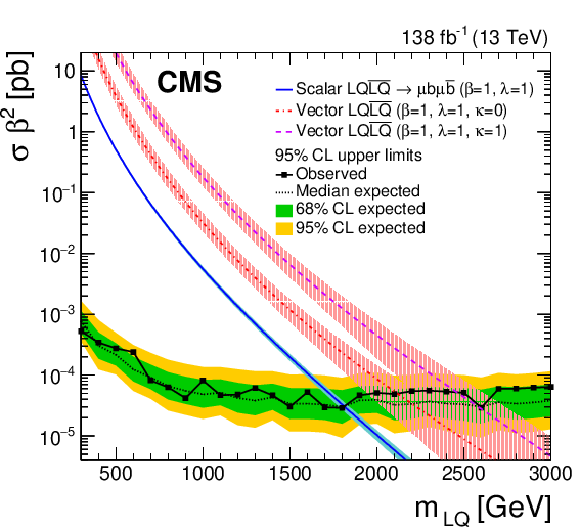
png pdf |
Figure 7:
The expected and observed upper limits at 95% CL on the product of the LQ pair production cross section and the branching fractions $ \beta^2 $ as a function of $ m_{\mathrm{LQ}} $. The black solid line represents the observed limits, the dotted line is for the median expected limits, and the inner dark-green and outer light-yellow bands are for the 68 and 95% CL intervals. The solid blue line and corresponding blue band represents the theoretical scalar LQ pair production cross sections and the uncertainties on the cross sections due to the PDF prediction and renormalization and factorization scales, respectively. Similarly, the dash-dotted (dashed) line and corresponding band represents the cross sections of theoretical vector LQ pair production and uncertainties in the minimal coupling (Yang-Mills) scenario. |
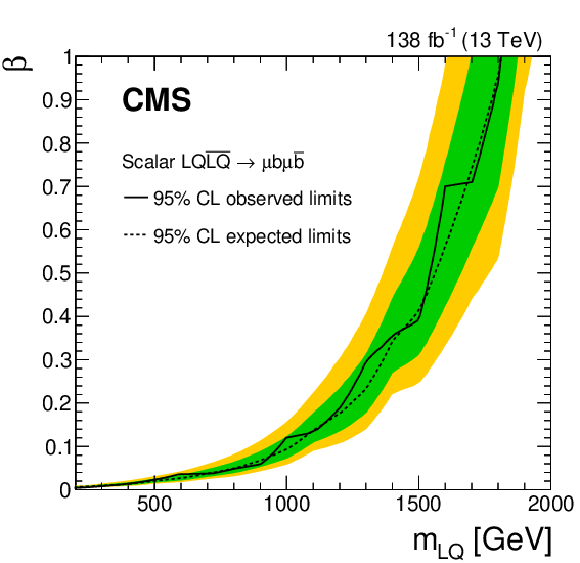
png pdf |
Figure 8:
The expected and observed exclusion limits at 95% CL as a function of the leptoquark mass and the branching fraction $ \beta $. The solid line represents the observed limits, the dashed line represents the median expected limits, and the inner dark-green and outer light-yellow bands represent the 68 and 95% CL intervals. The area left of the observed limit is excluded. |
| Tables | |

png pdf |
Table 1:
Systematic uncertainties in signal efficiency and background yields in the combined 2016-2018 data set, shown as a range over all final selections (second and third columns) as well as for the $ m_{\mathrm{LQ}} = $ 1800 GeV point (rightmost two columns). The last two rows show the total systematic and statistical uncertainties in the simulated samples. |
| Summary |
| A search has been performed for pair production of leptoquarks (LQs) decaying to muons and bottom quarks using proton-proton collision data collected at $ \sqrt{s} = $ 13 TeV in 2016-2018 with the CMS detector at the LHC, corresponding to an integrated luminosity of 138 fb$ ^{-1} $. Limits are set at 95% confidence level on the product of the scalar LQ pair production cross section and $ \beta^2 $, as a function of the LQ mass $ m_{\mathrm{LQ}} $, where $ \beta $ is the branching fraction of the LQ decaying to a muon and a bottom quark. Scalar LQs with $ m_{\mathrm{LQ}} < $ 1810 GeV are excluded for $ \beta= $ 1. The results are also presented as a function of $ \beta $, and scalar LQs with $ m_{\mathrm{LQ}} < $ 1540 GeV are excluded for $ \beta= $ 0.5. A further interpretation is performed with a vector LQ model, and vector LQs with $ m_{\mathrm{LQ}} < $ 2120 (2460) GeV are excluded in the minimal coupling (Yang-Mills) scenario for $ \beta= $ 1. These represent the most stringent limits to date on these models. |
| References | ||||
| 1 | J. C. Pati and A. Salam | Unified lepton-hadron symmetry and a gauge theory of the basic interactions | PRD 8 (1973) 1240 | |
| 2 | J. C. Pati and A. Salam | Lepton number as the fourth color | PRD 10 (1974) 275 | |
| 3 | H. Georgi and S. Glashow | Unity of all elementary-particle forces | PRL 32 (1974) 438 | |
| 4 | H. Fritzsch and P. Minkowski | United interactions of leptons and hadrons | Annals Phys. 93 (1975) 193 | |
| 5 | G. Senjanovi \'c and A. Sokorac | Light lepto-quarks in SO(10) | Z. Phys. C 20 (1983) 255 | |
| 6 | P. H. Frampton and B.-H. Lee | SU(15) grand unification | PRL 64 (1990) 619 | |
| 7 | P. H. Frampton and T. W. Kephart | Higgs sector and proton decay in SU(15q) grand unification | PRD 42 (1990) 3892 | |
| 8 | H. Murayama and T. Yanagida | A viable SU(5) GUT with light leptoquark bosons | Mod. Phys. Lett. A 07 (1992) 147 | |
| 9 | B. Schrempp and F. Schrempp | Light leptoquarks | PLB 153 (1985) 101 | |
| 10 | S. Dimopoulos and L. Susskind | Mass without scalars | NPB 155 (1979) 237 | |
| 11 | S. Dimopoulos | Technicolored signatures | NPB 168 (1980) 69 | |
| 12 | E. Eichten and K. Lane | Dynamical breaking of the weak interaction symmetries | PLB 90 (1980) 85 | |
| 13 | J. L. Hewett and T. G. Rizzo | Low-energy phenomenology of superstring-inspired E$ _{6} $ models | Phys. Rept. 183 (1989) 193 | |
| 14 | P. Ramond | Dual theory for free fermions | PRD 3 (1971) 2415 | |
| 15 | Y. A. Golfand and E. P. Likhtman | Extension of the algebra of Poincaré group generators and violation of p invariance | JETP Lett. 13 (1971) 323 | |
| 16 | A. Neveu and J. H. Schwarz | Factorizable dual model of pions | NPB 31 (1971) 86 | |
| 17 | D. V. Volkov and V. P. Akulov | Possible universal neutrino interaction | JETP Lett. 16 (1972) 438 | |
| 18 | J. Wess and B. Zumino | A Lagrangian model invariant under supergauge transformations | PLB 49 (1974) 52 | |
| 19 | J. Wess and B. Zumino | Supergauge transformations in four dimensions | NPB 70 (1974) 39 | |
| 20 | P. Fayet | Supergauge invariant extension of the Higgs mechanism and a model for the electron and its neutrino | NPB 90 (1975) 104 | |
| 21 | G. R. Farrar and P. Fayet | Phenomenology of the production, decay, and detection of new hadronic states associated with supersymmetry | PLB 76 (1978) 575 | |
| 22 | H. P. Nilles | Supersymmetry, supergravity and particle physics | Phys. Rept. 110 (1984) 1 | |
| 23 | R. Barbier et al. | R-parity violating supersymmetry | Phys. Rept. 420 (2005) 1 | hep-ph/0406039 |
| 24 | BaBar Collaboration | Evidence for an excess of $ \bar{B} \to D^{(*)} \tau^-\bar{\nu}_\tau $ decays | PRL 109 (2012) 101802 | 1205.5442 |
| 25 | BaBar Collaboration | Measurement of an Excess of $ \bar{B} \to D^{(*)}\tau^- \bar{\nu}_\tau $ Decays and Implications for Charged Higgs Bosons | PRD 88 (2013) 072012 | 1303.0571 |
| 26 | Belle Collaboration | Measurement of the branching ratio of $ \bar{B} \to D^{(\ast)} \tau^- \bar{\nu}_\tau $ relative to $ \bar{B} \to D^{(\ast)} \ell^- \bar{\nu}_\ell $ decays with hadronic tagging at Belle | PRD 92 (2015) 072014 | 1507.03233 |
| 27 | Belle Collaboration | Measurement of the $ \tau $ lepton polarization and $ R(D^*) $ in the decay $ \bar{B} \to D^* \tau^- \bar{\nu}_\tau $ | PRL 118 (2017) 211801 | 1612.00529 |
| 28 | Belle Collaboration | Measurement of the $ \tau $ lepton polarization and $ R(D^*) $ in the decay $ \bar{B} \rightarrow D^* \tau^- \bar{\nu}_\tau $ with one-prong hadronic $ \tau $ decays at Belle | PRD 97 (2018) 012004 | 1709.00129 |
| 29 | Belle Collaboration | Measurement of $ \mathcal{R}(D) $ and $ \mathcal{R}(D^*) $ with a semileptonic tagging method | PRL 124 (2020) 161803 | 1910.05864 |
| 30 | LHCb Collaboration | Measurement of the ratio of branching fractions $ \mathcal{B}(\bar{B}^0 \to D^{*+}\tau^{-}\bar{\nu}_{\tau})/\mathcal{B}(\bar{B}^0 \to D^{*+}\mu^{-}\bar{\nu}_{\mu}) $ | PRL 115 (2015) 111803 | 1506.08614 |
| 31 | LHCb Collaboration | Measurement of the ratio of the $ B^0 \to D^{*-} \tau^+ \nu_{\tau} $ and $ B^0 \to D^{*-} \mu^+ \nu_{\mu} $ branching fractions using three-prong $ \tau $-lepton decays | PRL 120 (2018) 171802 | 1708.08856 |
| 32 | LHCb Collaboration | Test of Lepton Flavor Universality by the measurement of the $ B^0 \to D^{*-} \tau^+ \nu_{\tau} $ branching fraction using three-prong $ \tau $ decays | PRD 97 (2018) 072013 | 1711.02505 |
| 33 | LHCb Collaboration | Measurement of the ratio of branching fractions $ \mathcal{B}(B_c^+\,\to\,J/\psi\tau^+\nu_\tau) $/$ \mathcal{B}(B_c^+\,\to\,J/\psi\mu^+\nu_\mu) $ | PRL 120 (2018) 121801 | 1711.05623 |
| 34 | LHCb Collaboration | Test of lepton flavor universality using $ B^0 \to D^{*-}\tau^+\nu_{\tau} $ decays with hadronic $ \tau $ channels | PRD 108 (2023) 012018 | 2305.01463 |
| 35 | LHCb Collaboration | Measurement of the ratios of branching fractions $ \mathcal{R}(D^{*}) $ and $ \mathcal{R}(D^{0}) $ | Submitted to Phys. Rev. Lett., 2023 | 2302.02886 |
| 36 | Muon $g$-2 Collaboration | Final report of the E821 muon anomalous magnetic moment measurement at BNL | PRD 73 (2006) 072003 | hep-ex/0602035 |
| 37 | Muon $g$-2 Collaboration | Measurement of the Positive Muon Anomalous Magnetic Moment to 0.46 ppm | PRL 126 (2021) 141801 | 2104.03281 |
| 38 | Muon $g$-2 Collaboration | Measurement of the Positive Muon Anomalous Magnetic Moment to 0.20 ppm | PRL 131 (2023) 161802 | 2308.06230 |
| 39 | I. Dor \v s ner et al. | Physics of leptoquarks in precision experiments and at particle colliders | Phys. Rept. 641 (2016) 1 | 1603.04993 |
| 40 | B. Diaz, M. Schmaltz, and Y.-M. Zhong | The leptoquark Hunter's guide: Pair production | JHEP 10 (2017) 097 | 1706.05033 |
| 41 | D. Buttazzo, A. Greljo, G. Isidori, and D. Marzocca | B-physics anomalies: a guide to combined explanations | JHEP 11 (2017) 44 | 1706.07808 |
| 42 | L. Calibbi, A. Crivellin, and T. Li | Model of vector leptoquarks in view of the $ B $-physics anomalies | PRD 98 (2018) 115002 | 1709.00692 |
| 43 | G. Hiller, D. Loose, and I. Ni \v s and \v z i \' c | Flavorful leptoquarks at hadron colliders | PRD 97 (2018) 075004 | 1801.09399 |
| 44 | I. Dor \v s ner, S. Fajfer, and A. Greljo | Cornering scalar leptoquarks at LHC | JHEP 10 (2014) 154 | 1406.4831 |
| 45 | W. Buchm \"u ller, R. R \"u ckl, and D. Wyler | Leptoquarks in lepton-quark collisions | PLB 191 (1987) 442 | |
| 46 | J. Blumlein, E. Boos, and A. Kryukov | Leptoquark pair production in hadronic interactions | Z. Phys. C 76 (1997) 137 | hep-ph/9610408 |
| 47 | CMS Collaboration | Search for pair production of first and second generation leptoquarks in proton-proton collisions at $ \sqrt{s} $ = 8 TeV | PRD 93 (2016) 032004 | CMS-EXO-12-041 1509.03744 |
| 48 | CMS Collaboration | Search for pair production of second-generation leptoquarks at $ \sqrt{s}= $ 13 TeV | PRD 99 (2019) 032014 | CMS-EXO-17-003 1808.05082 |
| 49 | ATLAS Collaboration | Search for pairs of scalar leptoquarks decaying into quarks and electrons or muons in $ \sqrt{s} $ = 13 TeV $ pp $ collisions with the ATLAS detector | JHEP 10 (2020) 112 | 2006.05872 |
| 50 | ATLAS Collaboration | Search for pair-produced scalar and vector leptoquarks decaying into third-generation quarks and first- or second-generation leptons in $ pp $ collisions with the ATLAS detector | JHEP 06 (2023) 188 | 2210.04517 |
| 51 | ATLAS Collaboration | Combination of searches for pair-produced leptoquarks at $ \sqrt{s} = $ 13 TeV with the ATLAS detector | Phys. Lett. B (to be published), 2024 | 2401.11928 |
| 52 | CMS Collaboration | The CMS experiment at the CERN LHC | JINST 3 (2008) S08004 | |
| 53 | CMS Collaboration | Performance of the CMS Level-1 trigger in proton-proton collisions at $ \sqrt{s} = $ 13\,TeV | JINST 15 (2020) P10017 | CMS-TRG-17-001 2006.10165 |
| 54 | CMS Collaboration | The CMS trigger system | JINST 12 (2017) P01020 | CMS-TRG-12-001 1609.02366 |
| 55 | CMS Collaboration | Technical Proposal for the Phase-II Upgrade of the CMS Detector | Technical Report CMS-TDR-15-02, . https://cds.cern.ch/record/886, 2015 CDS |
|
| 56 | CMS Collaboration | Particle-flow reconstruction and global event description with the CMS detector | JINST 12 (2017) P10003 | CMS-PRF-14-001 1706.04965 |
| 57 | E. Bols et al. | Jet flavour classification using DeepJet | JINST 15 (2020) P12012 | 2008.10519 |
| 58 | CMS Collaboration | Identification of heavy-flavour jets with the CMS detector in pp collisions at 13 TeV | JINST 13 (2018) P05011 | CMS-BTV-16-002 1712.07158 |
| 59 | CMS Collaboration | Performance summary of AK4 jet b tagging with data from proton-proton collisions at 13 TeV with the CMS detector | CMS Detector Performance Note CMS-DP-2023-005, . http://cds.cern.ch/record/2854609, 2023 CDS |
|
| 60 | M. Cacciari, G. P. Salam, and G. Soyez | The anti-$ k_\text{T} $ jet clustering algorithm | JHEP 04 (2008) 063 | 0802.1189 |
| 61 | M. Cacciari, G. P. Salam, and G. Soyez | FastJet user manual | EPJC 72 (2012) 1896 | 1111.6097 |
| 62 | CMS Collaboration | Pileup mitigation at CMS in 13 TeV data | JINST 15 (2020) P09018 | CMS-JME-18-001 2003.00503 |
| 63 | CMS Collaboration | Jet energy scale and resolution in the CMS experiment in pp collisions at 8 TeV | JINST 12 (2017) P02014 | CMS-JME-13-004 1607.03663 |
| 64 | CMS Collaboration | Performance of the CMS muon detector and muon reconstruction with proton-proton collisions at $ \sqrt{s}= $ 13 TeV | JINST 13 (2018) P06015 | CMS-MUO-16-001 1804.04528 |
| 65 | CMS Collaboration | Performance of missing transverse momentum reconstruction in proton-proton collisions at $ \sqrt{s} = $ 13\,TeV using the CMS detector | JINST 14 (2019) P07004 | CMS-JME-17-001 1903.06078 |
| 66 | CMS Collaboration | Precision luminosity measurement in proton-proton collisions at $ \sqrt{s}= $ 13 TeV in 2015 and 2016 at CMS | EPJC 81 (2021) 800 | CMS-LUM-17-003 2104.01927 |
| 67 | CMS Collaboration | CMS luminosity measurement for the 2017 data-taking period at $ \sqrt{s}= $ 13 TeV | CMS Physics Analysis Summary , . http://cds.cern.ch/record/262, 2018 CMS-PAS-LUM-17-004 |
CMS-PAS-LUM-17-004 |
| 68 | CMS Collaboration | CMS luminosity measurement for the 2018 data-taking period at $ \sqrt{s}= $ 13 TeV | CMS Physics Analysis Summary , . http://cds.cern.ch/record/2676164, 2019 CMS-PAS-LUM-18-002 |
CMS-PAS-LUM-18-002 |
| 69 | S. Frixione and B. R. Webber | Matching NLO QCD computations and parton shower simulations | JHEP 06 (2002) 029 | hep-ph/0204244 |
| 70 | J. Alwall et al. | The automated computation of tree-level and next-to-leading order differential cross sections, and their matching to parton shower simulations | JHEP 07 (2014) 079 | 1405.0301 |
| 71 | R. Frederix and S. Frixione | Merging meets matching in MC@NLO | JHEP 12 (2012) 061 | 1209.6215 |
| 72 | S. Frixione, P. Nason, and C. Oleari | Matching NLO QCD computations with parton shower simulations: the POWHEG method | JHEP 11 (2007) 070 | 0709.2092 |
| 73 | S. Alioli, P. Nason, C. Oleari, and E. Re | NLO vector-boson production matched with shower in POWHEG | JHEP 07 (2008) 060 | 0805.4802 |
| 74 | S. Alioli, P. Nason, C. Oleari, and E. Re | NLO single-top production matched with shower in POWHEG: $ s $- and $ t $-channel contributions | JHEP 09 (2009) 111 | 0907.4076 |
| 75 | S. Alioli, P. Nason, C. Oleari, and E. Re | A general framework for implementing NLO calculations in shower Monte Carlo programs: the POWHEG BOX | JHEP 06 (2010) 043 | 1002.2581 |
| 76 | S. Frixione, E. Laenen, P. Motylinski, and B. R. Webber | Single-top production in MC@NLO | JHEP 03 (2006) 092 | hep-ph/0512250 |
| 77 | T. Sjöstrand et al. | An Introduction to PYTHIA 8.2 | Comput. Phys. Commun. 191 (2015) 159 | 1410.3012 |
| 78 | NNPDF Collaboration | Parton distributions for the LHC Run II | JHEP 04 (2015) 040 | 1410.8849 |
| 79 | GEANT4 Collaboration | GEANT 4---A simulation toolkit | NIM A 506 (2003) 250 | |
| 80 | J. Allison et al. | GEANT 4 developments and applications | IEEE Trans. Nucl. Sci. 53 (2006) 270 | |
| 81 | CMS Collaboration | Event generator tunes obtained from underlying event and multiparton scattering measurements | EPJC 76 (2016) 155 | CMS-GEN-14-001 1512.00815 |
| 82 | CMS Collaboration | Extraction and validation of a new set of CMS PYTHIA8 tunes from underlying-event measurements | EPJC 80 (2020) 4 | CMS-GEN-17-001 1903.12179 |
| 83 | I. Dor \v s ner and A. Greljo | Leptoquark toolbox for precision collider studies | JHEP 05 (2018) 126 | 1801.07641 |
| 84 | M. Kramer, T. Plehn, M. Spira, and P. M. Zerwas | Pair production of scalar leptoquarks at the CERN LHC | PRD 71 (2005) 057503 | hep-ph/0411038 |
| 85 | T. Mandal, S. Mitra, and S. Seth | Pair Production of scalar leptoquarks at the LHC to NLO parton shower accuracy | PRD 93 (2016) 035018 | 1506.07369 |
| 86 | J. Butterworth et al. | PDF4LHC recommendations for LHC Run II | JPG 43 (2016) 023001 | 1510.03865 |
| 87 | L. Mason, J. Baxter, P. L. Bartlett, and M. Frean | Boosting algorithms as gradient descent | in, 2000 Advances in Neural Information Processing Systems 1 (2000) 512 |
|
| 88 | J. H. Friedman | Greedy function approximation: A gradient boosting machine. | Annals Statist. 29 (2001) 1189 | |
| 89 | J. H. Friedman | Stochastic gradient boosting | Comput. Stat. Data Anal. 38 (2002) 367 | |
| 90 | G. Punzi | Sensitivity of searches for new signals and its optimization | in Statistical problems in particle physics, astrophysics and cosmology. Proceedings, Conference, PHYSTAT, Stanford, USA, September 8-11,, 2003 link |
physics/0308063 |
| 91 | CMS Collaboration | HEPData record for this analysis | link | |
| 92 | CMS Collaboration | Search for high-mass resonances in dilepton final states in proton-proton collisions at $ \sqrt{s}= $ 13 TeV | JHEP 06 (2018) 120 | CMS-EXO-16-047 1803.06292 |
| 93 | D. Bourilkov, R. C. Group, and M. R. Whalley | LHAPDF: PDF use from the Tevatron to the LHC | hep-ph/0605240 | |
| 94 | CMS Collaboration | Measurement of the inelastic proton-proton cross section at $ \sqrt{s}= $ 13 TeV | JHEP 07 (2018) 161 | CMS-FSQ-15-005 1802.02613 |
| 95 | CMS Collaboration | Measurement of differential cross sections for top quark pair production using the lepton+jets final state in proton-proton collisions at 13 TeV | PRD 95 (2017) 092001 | CMS-TOP-16-008 1610.04191 |
| 96 | G. Cowan, K. Cranmer, E. Gross, and O. Vitells | Asymptotic formulae for likelihood-based tests of new physics | EPJC 71 (2011) 1554 | 1007.1727 |
| 97 | T. Junk | Confidence level computation for combining searches with small statistics | NIM A 434 (1999) 435 | hep-ex/9902006 |
| 98 | A. L. Read | Presentation of search results: The CL$ _{\rm{s}} $ technique | JPG 28 (2002) 2693 | |
| 99 | J. B. Hammett and D. A. Ross | NLO leptoquark production and decay: the narrow-width approximation and beyond | JHEP 07 (2015) 148 | 1501.06719 |

|
Compact Muon Solenoid LHC, CERN |

|

|

|

|

|

|